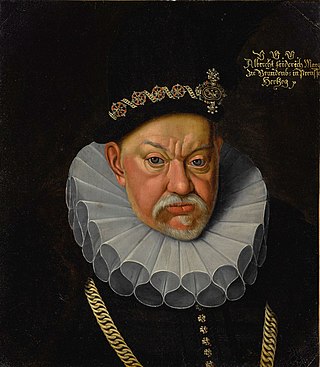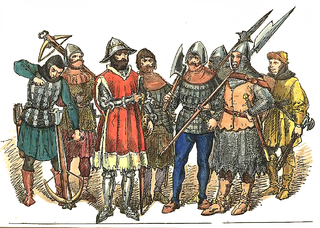
Albert of Prussia was a German prince who was the 37th grand master of the Teutonic Knights and, after converting to Lutheranism, became the first ruler of the Duchy of Prussia, the secularized state that emerged from the former Monastic State of the Teutonic Knights. Albert was the first European ruler to establish Lutheranism, and thus Protestantism, as the official state religion of his lands. He proved instrumental in the political spread of Protestantism in its early stage, ruling the Prussian lands for nearly six decades (1510–1568).

Albert Frederick was the Duke of Prussia, from 1568 until his death. He was a son of Albert of Prussia and Anna Marie of Brunswick-Lüneburg. He was the second and last Prussian duke of the Ansbach branch of the Hohenzollern family.

Sigismund I the Old was King of Poland and Grand Duke of Lithuania from 1506 until his death in 1548. Sigismund I was a member of the Jagiellonian dynasty, the son of Casimir IV and younger brother of Kings John I Albert and Alexander I Jagiellon. He was nicknamed "the Old" in later historiography to distinguish him from his son and successor, Sigismund II Augustus. Before ascending to the Polish and Lithuanian thrones, he was Duke of Głogów from 1499, Duke of Opava from 1501, and governor of Silesia from 1504 on behalf of his brother, King Vladislaus II of Bohemia and Hungary.

The Peace of Thorn or Toruń of 1466, also known as the Second Peace of Thorn or Toruń, was a peace treaty signed in the Hanseatic city of Thorn (Toruń) on 19 October 1466 between the Polish king Casimir IV Jagiellon and the Teutonic Knights, which ended the Thirteen Years' War, the longest of the Polish–Teutonic Wars.

Royal Prussia or Polish Prussia became a province of the Crown of the Kingdom of Poland, which was annexed following the imposed Second Peace of Toruń (1466) from territory in Pomerelia and western Prussia which had been part of the State of the Teutonic Order. Royal Prussia retained its autonomy, governing itself and maintaining its own laws, customs, rights and German language for the German minority and Polish language for the Polish majority.

The Duchy of Prussia or Ducal Prussia was a duchy in the region of Prussia established as a result of secularization of the Monastic Prussia, the territory that remained under the control of the State of the Teutonic Order until the Protestant Reformation in 1525.

The State of the Teutonic Order was a theocratic state located along the southeastern shore of the Baltic Sea in northern Europe. It was formed by the knights of the Teutonic Order during the early 13th century Northern Crusades in the region of Prussia. In 1237, the Livonian Brothers of the Sword merged with the Teutonic Order of Prussia and became known as its branch – the Livonian Order. At its greatest territorial extent during the early 15th century, the State encompassed Chełmno Land, Courland, Gotland, Livonia, Estonia, Neumark, Pomerelia, Prussia and Samogitia.

Subdivisions of the Polish–Lithuanian Commonwealth evolved over for centuries of its existence from the signing of the Union of Lublin to the third partition.
This is the 1467-1479 Polish-Teutonic War. For a list of all Polish-German Wars, see Polish-German Wars.

Johann von Tiefen was the 35th Grand Master of the Teutonic Knights, serving from 1489 to 1497.

Olsztynek is a town in northern Poland, in Olsztyn County, in the Warmian-Masurian Voivodeship. It is the administrative seat of Gmina Olsztynek. It is part of the historic region of Masuria.
This is the 1519-1521 Polish-Teutonic War. For a list of all Polish-German Wars, see Polish-German Wars.

Polish–Teutonic Wars refer to a series of conflicts that took place between the Kingdom of Poland and the Teutonic Order, a medieval German military order with roots in the Baltic region. These wars occurred primarily during the 14th and 15th centuries and were characterized by territorial disputes, political maneuvering, and religious differences.

This is the 1454-1466 Polish-Teutonic War. For a list of all Polish-German Wars, see Polish-German Wars.

Sophia of Poland, was a Polish princess, member of the Jagiellonian dynasty, great-granddaughter of Emperor Sigismund and by marriage Margravine of Brandenburg-Ansbach and Brandenburg-Kulmbach.

The rule of the Jagiellonian dynasty in Poland between 1386 and 1572 spans the Late Middle Ages and the Early Modern Period in European history. The Lithuanian Grand Duke Jogaila founded the dynasty; his marriage to Queen Jadwiga of Poland in 1386 strengthened an ongoing Polish–Lithuanian union. The partnership brought vast territories controlled by the Grand Duchy of Lithuania into Poland's sphere of influence and proved beneficial for both the Polish and Lithuanian people, who coexisted and cooperated in one of the largest political entities in Europe for the next four centuries.

The Prussian Homage is an oil on canvas painting by Polish painter Jan Matejko painted between 1879 and 1882 in Kraków. The painting depicts the "Prussian Homage", a significant political event from the time of the Renaissance in Poland in which Albrecht of Hohenzollern, the Duke of Prussia paid tribute and swore allegiance to King Sigismund I the Old in Kraków's market square on 10 April 1525. Matejko depicted over thirty important figures of the Polish Renaissance period, taking the liberty of including several who were not actually present at the event.

The history of Poles in Königsberg goes back to the 14th century. In the struggles between the Kingdom of Poland and the Teutonic Order, the city was briefly part of the Polish state, and after the Second Peace of Toruń, 1466, it was considered a part of Poland as a fief held by the Teutonic Order and the secular Duchy of Prussia, as the capital of both entities. During the Protestant Reformation Königsberg became the center of Polish Lutheranism and partially for this reason, a birthplace of Polish printing and one of the epicenters of vernacular Polish literature. Polish intellectuals and scholars played a major role in the founding of the University of Königsberg (Albertina) and served as both faculty and administrators.

The Prince-Bishopric of Warmia was a semi-independent ecclesiastical state, ruled by the incumbent ordinary of the Warmia see and comprising one third of the then diocesan area. The Warmia see was a Prussian diocese under the jurisdiction of the Archbishopric of Riga that was a protectorate of the Monastic state of the Teutonic Knights (1243–1464) and a protectorate and part of the Kingdom of Poland—later part of the Polish–Lithuanian Commonwealth (1464–1772), confirmed by the Peace of Thorn in 1466. The other two thirds of the diocese were under the secular rule of the Teutonic Knights until 1525 and Ducal Prussia thereafter, both entities also being a protectorate and part of Poland from 1466.

The 1648 free election in the Polish–Lithuanian Commonwealth began on 6 October 1648, and ended on November 17 of the same year. The new King of Poland and Grand Duke of Lithuania was John II Casimir, the younger brother of previous king, Władysław IV, who had died on May 20, 1648.



















